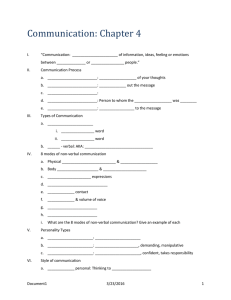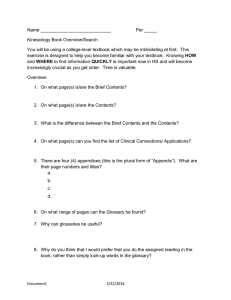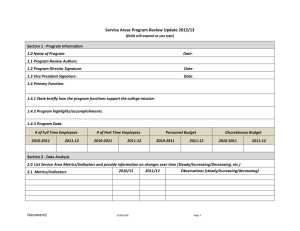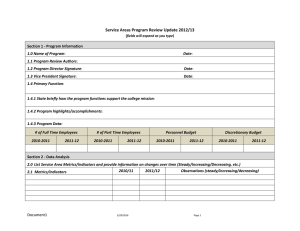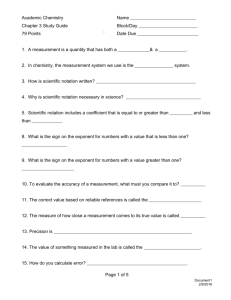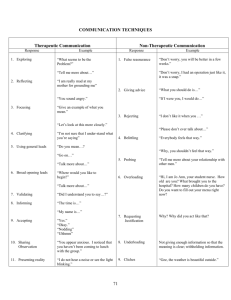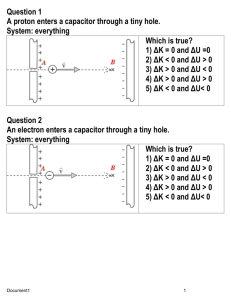Handout 1 - Porterville College
advertisement
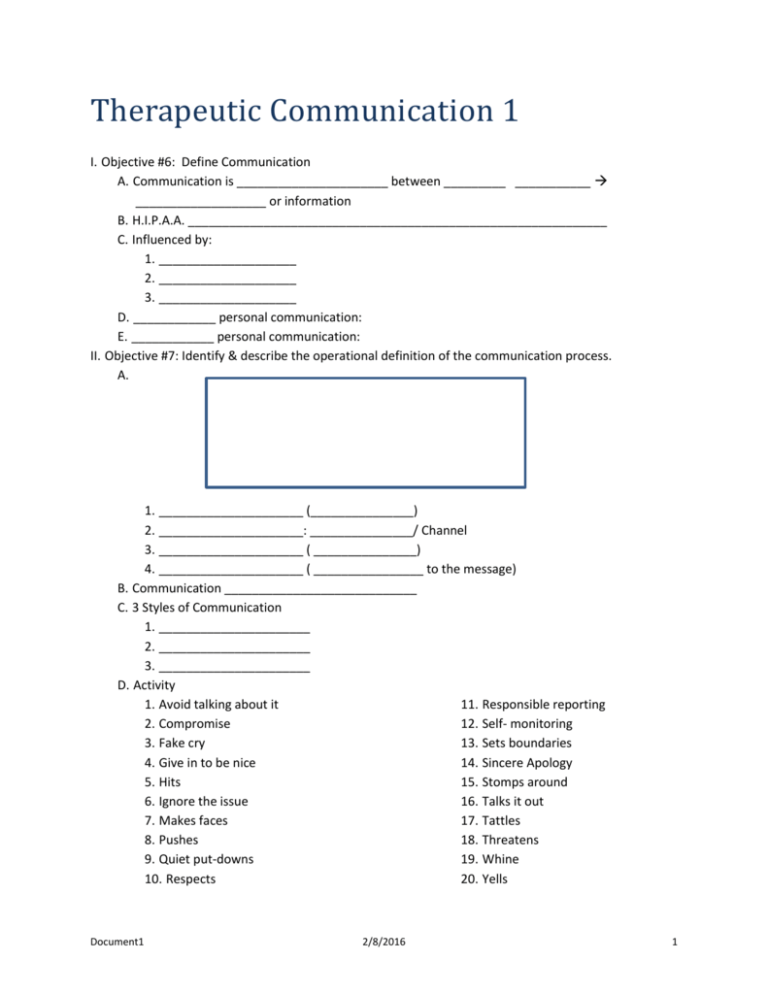
Therapeutic Communication 1 I. Objective #6: Define Communication A. Communication is ______________________ between _________ ___________ ___________________ or information B. H.I.P.A.A. _____________________________________________________________ C. Influenced by: 1. ____________________ 2. ____________________ 3. ____________________ D. ____________ personal communication: E. ____________ personal communication: II. Objective #7: Identify & describe the operational definition of the communication process. A. 1. _____________________ (_______________) 2. _____________________: _______________/ Channel 3. _____________________ ( _______________) 4. _____________________ ( ________________ to the message) B. Communication ____________________________ C. 3 Styles of Communication 1. ______________________ 2. ______________________ 3. ______________________ D. Activity 1. Avoid talking about it 11. Responsible reporting 2. Compromise 12. Self- monitoring 3. Fake cry 13. Sets boundaries 4. Give in to be nice 14. Sincere Apology 5. Hits 15. Stomps around 6. Ignore the issue 16. Talks it out 7. Makes faces 17. Tattles 8. Pushes 18. Threatens 9. Quiet put-downs 19. Whine 10. Respects 20. Yells Document1 2/8/2016 1 III. Objective #8: List the two main channels of communication. A. Verbal 1. Spoken __________________ 2. Written __________________ B. Non-verbal: ____________________ AKA: _____________ language 1. Physical ________________________ 2. Body ______________________ & ___________________ 3. ________________ expressions 4. ________________ 5. ___________ contact 6. _____________________ --------------7. ____________ & _______________ of voice 8. ______________________ C. Communicating Relationships 1. Kinestic: __________________ 2. Tone / Para-verbal: __________________ 3. Verbal: _________________ D. People Reading 1. Emotional ___________________ Expressions (Dr. Paul Ekman) a. _________________ (wrath / rage) b. _________________ (Disrespect/ intense dislike) c. _________________ (Aversion/repugnance) d. _________________ (agitation / anxiety) e. _________________ (Pleasure/ contentment) f. _________________ (Sorrow) g. _________________ (Sudden/ unexpected) E. Therapeutic non-verbal 1. S:___________________________ 2. O:___________________________ 3. L:___________________________ 4. E:___________________________ 5. R:___________________________ IV. Explain what is meant by the Nurse / Psych Tech – Patient relationship A. Professional _________________________: The _____________ maintained between a person who is __________________________ (the client) and the person with _____________ (nurse) B. Therapeutic Relationships: Characteristics 1. Interaction _________________________ 2. ___________ oriented 3. ___________________ 4. ___________________ 5. ___________________ Document1 2/8/2016 2 Empathy _________________________ pt. emotions Shows care by ___________________ & _________________________ Sympathy ______________ some of the pt problems Feels _________________ for them C. Emotional Separateness a. Self - _______________________ b. Self - _______________________ c. Self - _______________________ V. Objecting #10: Describe why therapeutic communication is the most important tool used by the PT A. TC is _________________ focused. B. ______________________ is the key C. Elements of TC 1. _____________________ 2. _____________________ 3. _____________________ 4. _____________________ 5. Self - ________________________ 6. Active _______________________ D. Goal of T.C. (Nurse) 1. Show _______________________ 2. Develop _____________________ 3. Provide / obtain _______________________ 4. ______ understanding E. Goal of T.C. (Client) 1. Explore ________________________ 2. _________ insight 3. _________ self- worth 4. Enc. ______________________________ solving 5. Facilitate __________________________ making F. Traits 1. _________ judgmental 8. ______________ desire to help 2. Good __________________ 9. _______________ who you are 3. ________________ like people 10. Exhibits __________________ 4. ____________ body language 11. _________________________ 5. Good eye _________________ 12. Appropriate _______________ 6. Classifies what they ___________ 13. ________________ 7. __________________ 14. Sensitivity & _______________ Document1 2/8/2016 3
